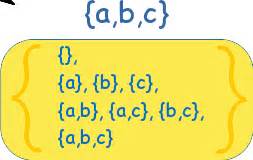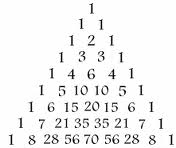- Your quiz today will be over distinguishing knots and links:
tricolorability and the Reidemeister moves.
- You have a reading
assignment over infinity.
- Suesana discovered this Netflix documentary, A Trip to
Infinity; I haven't seen it, but apparently at nine minutes
in there's a discussion of Hilbert's Hotel which Suesana
found useful.
Kellie suggested that Frank Baum's story The Queen of Quok would make good infinity reading, too!
- Time for another art contest! Here is the (juried)
gallery.
I'll flash through them, you vote, and some of you will get an extra "get out of quiz free" card.
- Reminder: we're a week and a half from our project and logo demonstrations (the last week of
class).
Don't wait for the last minute! (It usually shows, if you do....:_ )
- We did a review of some of the knot niceties.
- Reviewed two of Zeno's paradoxes:
- Achilles and the Tortoise (the Tortoise beats Achilles.)
- The Dichotomy paradox (Motion is impossible.)
- Reviewed some terminology, and added some new:
- Cardinality
- Set
- Subset
- Element
- Power Set -- this was the most important new thing!
The power set of a set \(S\) is the set of all of S's subsets, and denoted \(P(S)\).
- And we continue on with Infinity, reviewing Hilbert's Hotel, and
the strange things we'd already seen.
Turns out the even natural numbers are as numerous as the natural numbers themselves, which seems troublesome. Subsets created from a set by throwing out a bunch of elements are not supposed to be the same size as the original set -- but things are a little different when it comes to infinite sets.
I want revisit one of the things we looked at last time: Assigning students on the infinite number of infinitely large buses (but doing it from a graph):

(for this one, you can see that the two sets are actually in a one-to-one correspondence; for the others, we see that the natural numbers are at least as big as an infinite number of copies of the natural numbers -- but that should seem pretty obvious...!:).
If I put the people in the Hotel in the first column (we'll call it Bus 1), you can see that they go into the rooms numbered by the triangular numbers: 1, 3, 6, 10, 15, ....
\[ n \longrightarrow \frac{n(n+1)}{2} \] More generally, for the person sitting in seat \(s\) on bus \(b\), \((b,s)\), \[ (b,s) \longrightarrow \frac{1}{2}\left(b^2+b(2s-3)+s^2-s+2\right) \] This is a one-to-one correspondence between the natural numbers and infinitely many copies of the natural numbers.
Looking at it another way, we can see that the rational numbers (ratios of natural numbers, and the negatives of those) are the same size (have the same cardinality) as the natural numbers:If we think of a bus/seat pair as a fraction, \((b,s) \equiv \frac{b}{s}\) we see that every positive rational number has its own room within the natural numbers. In fact, they have infinitely many rooms, since, for example, \[ \frac{1}{1} = \frac{2}{2} = \frac{3}{3} = \frac{4}{4} = \ldots \] all get rooms (but they're the same rational number!).
Question of the day:
- The natural numbers are infinite in number (the size of the set is
larger than any natural number). It is called a
countable infinity (or denumerable), because, well, we
can start counting it! (We just never get to the end -- it will
take us an eternity).
We're going to revisit the natural numbers first, to show that their power set is bigger than the naturals. (How will we know that?)
- Let's review our handout from last time, and make sure that we're
all on-board.
- Here's the upshot of what Cantor discovered:
- Some mathematical facts:
- Mathematical fact zero:
- A set S is just a collection of objects; and a
subset of S is just what you'd expect: some members of
S. It may be all the members, in which we call it an
"improper" subset, or it may be none of them (in which
case we call it the empty set).
We often denote a set by using braces, e.g. \(S=\{1,2,3\}\) is the set of the first three natural numbers.
We say that \(a\) is an element of \(S\) if \(a\) is contained in \(S\), and we write \(a \in S\). So \(1 \in S\), \(2 \in S\), and \(3 \in S\). We deny that an object is in \(S\) this way: \(4 \notin S\).
- Mathematical fact one:
- A subset is never bigger in size than the set
itself.
And if the sets are finite, the proper subset is always smaller, but if the set is infinite, we may actually be able to throw away elements of a set and not change the size of the set!
- Mathematical fact two:
- Let's call the set of all of a set S's subsets its
power set, \(P(S)\). Pascal's triangle (that rascal!)
shows you how many of each type of subset you have (for finite
sets).
13
3
1


- Mathematical fact three:
- The power set of a set of $n$ elements contains $2^n$
elements.
(We know that since each row of Pascal's triangle adds to a power of 2.)
- Mathematical fact zero:
- Even the set containing no elements has one subset -- the set
itself. So the power set has one element -- has size bigger
than the set itself.
This property holds true for all finite sets -- and it turns out to be true for infinite sets, too!
Here's a silly video to illustrate how the power set grows with sets of increasing size. (Thanks to Dr. Towanna Roller (Asbury University) and her daughter Kristyn Roller (UK) for this one!)
- This means that, although the natural numbers $1,2,3,\ldots$ is
infinite as a set, there's a bigger set (the power set of the
natural numbers).
Imagine not: then we can set up a one-to-one correspondence between the natural numbers and its power set,
and we enthusiastically claim that we've somehow managed to find a natural number partner for every subset of the natural numbers. Except....\(n \in N\) \(ss(n) \in P(N)\) 1 \(N\) 2 {} 3 odds 4 primes 5 {1,2} 6 evens 7 Fibonaccis ... ... We can find a subset of \(N\) that's not on the right hand side! That is, we can show that it's not really one-to-one, because there's a subset that's not at the dance (a tango!) -- that had no partner, and so is sitting quietly and sadly at home, perhaps even crying quietly....
We construct this sad set as follows:
We will call \(ss(n)\) the partner subset corresponding to a natural number \(n\); and we construct the set \(A\), the lonely set, by the following rule: for each natural number \(n\), we either add \(n\) to \(A\) or not, depending on whether \(n \in ss(n)\):
If \(n \in ss(n)\), then \(n \notin A\)
If \(n \notin ss(n)\), then \(n \in A\)
And by this means, we can see that \(A\) is different from every \(ss(n)\) that's gone to the dance, and so \(A\) says to itself sadly, "Well, I guess tonight I'll be dancing by myself!"
- And the power set of the natural numbers is a set, having a power
set of its own: \(P(P(N))\). And that power set is bigger yet,
and so on, and on and on, and on, and on, and on, and so on
forever, forever, Hallelujah, Hallelujah!
-
Upshot: infinity comes in various sizes! Infinitely
many, in fact. Crazy sounding, I know -- but it's true.
That symbol that you've been familiar with for all your lives, $\infty$: you thought it stood for a single thing; but it stands for a whole collection of monstrously big things, all too big to really think about properly. (Well, Cantor did!:)
- That's too crazy, it seems; but, nonetheless, mathematicians
know that it's true, because we can prove it! The key to
determining if two sets have the same size is the one-to-one
correspondence -- and that is key for infinite sets, as well.
- So, in the end, here's what you say on the playground,
when you want to love your friend more:
"I love you more than the power set of your set of infinite love."

Amen!
- Some mathematical facts: